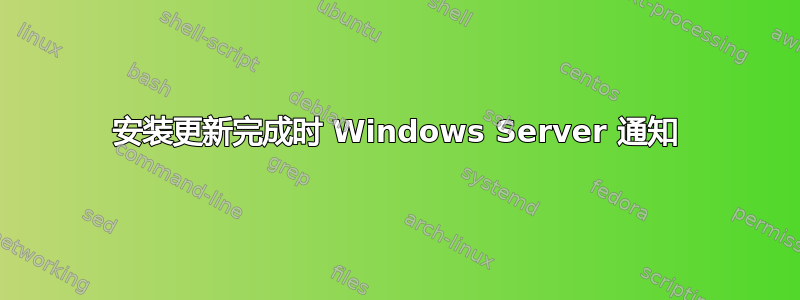
我们环境中的 Windows Server(2008 R2 和 2012 R2)每月自动安装一次更新,但不会自动重启(目前),因为 WSUS 服务器应该是最后重启的服务器,并且并非所有域控制器都应同时重启。如何设置一个系统,让每个服务器在完成所有更新安装后向另一台服务器报告?我想编写一个脚本来获取服务器的更新状态,然后决定是否允许服务器重启。
另外,我通常会错过(WSUS/Windows)更新通知,例如,如果更新失败,我希望收到通知,而不必手动检查每个服务器。
答案1
TechNet 上有很多脚本可用于查询所需的重启。MSFT 员工提供了此脚本。您可以根据需要在脚本中添加 Restart-Computer cmdlet 以满足您的需求。
请参阅那篇解释该脚本的博客文章。 确定待处理的重启状态 - PowerShell 风格!第 1 部分 确定待处理的重启状态 - PowerShell 风格!第 2 部分
链接至脚本。 Get-PendingReboot - 查询计算机的待定重启状态
Function Get-PendingReboot
{
<#
.SYNOPSIS
Gets the pending reboot status on a local or remote computer.
.DESCRIPTION
This function will query the registry on a local or remote computer and determine if the
system is pending a reboot, from Microsoft updates, Configuration Manager Client SDK, Pending Computer
Rename, Domain Join or Pending File Rename Operations. For Windows 2008+ the function will query the
CBS registry key as another factor in determining pending reboot state. "PendingFileRenameOperations"
and "Auto Update\RebootRequired" are observed as being consistant across Windows Server 2003 & 2008.
CBServicing = Component Based Servicing (Windows 2008+)
WindowsUpdate = Windows Update / Auto Update (Windows 2003+)
CCMClientSDK = SCCM 2012 Clients only (DetermineIfRebootPending method) otherwise $null value
PendComputerRename = Detects either a computer rename or domain join operation (Windows 2003+)
PendFileRename = PendingFileRenameOperations (Windows 2003+)
PendFileRenVal = PendingFilerenameOperations registry value; used to filter if need be, some Anti-
Virus leverage this key for def/dat removal, giving a false positive PendingReboot
.PARAMETER ComputerName
A single Computer or an array of computer names. The default is localhost ($env:COMPUTERNAME).
.PARAMETER ErrorLog
A single path to send error data to a log file.
.EXAMPLE
PS C:\> Get-PendingReboot -ComputerName (Get-Content C:\ServerList.txt) | Format-Table -AutoSize
Computer CBServicing WindowsUpdate CCMClientSDK PendFileRename PendFileRenVal RebootPending
-------- ----------- ------------- ------------ -------------- -------------- -------------
DC01 False False False False
DC02 False False False False
FS01 False False False False
This example will capture the contents of C:\ServerList.txt and query the pending reboot
information from the systems contained in the file and display the output in a table. The
null values are by design, since these systems do not have the SCCM 2012 client installed,
nor was the PendingFileRenameOperations value populated.
.EXAMPLE
PS C:\> Get-PendingReboot
Computer : WKS01
CBServicing : False
WindowsUpdate : True
CCMClient : False
PendComputerRename : False
PendFileRename : False
PendFileRenVal :
RebootPending : True
This example will query the local machine for pending reboot information.
.EXAMPLE
PS C:\> $Servers = Get-Content C:\Servers.txt
PS C:\> Get-PendingReboot -Computer $Servers | Export-Csv C:\PendingRebootReport.csv -NoTypeInformation
This example will create a report that contains pending reboot information.
.LINK
Component-Based Servicing:
http://technet.microsoft.com/en-us/library/cc756291(v=WS.10).aspx
PendingFileRename/Auto Update:
http://support.microsoft.com/kb/2723674
http://technet.microsoft.com/en-us/library/cc960241.aspx
http://blogs.msdn.com/b/hansr/archive/2006/02/17/patchreboot.aspx
SCCM 2012/CCM_ClientSDK:
http://msdn.microsoft.com/en-us/library/jj902723.aspx
.NOTES
Author: Brian Wilhite
Email: bcwilhite (at) live.com
Date: 29AUG2012
PSVer: 2.0/3.0/4.0/5.0
Updated: 27JUL2015
UpdNote: Added Domain Join detection to PendComputerRename, does not detect Workgroup Join/Change
Fixed Bug where a computer rename was not detected in 2008 R2 and above if a domain join occurred at the same time.
Fixed Bug where the CBServicing wasn't detected on Windows 10 and/or Windows Server Technical Preview (2016)
Added CCMClient property - Used with SCCM 2012 Clients only
Added ValueFromPipelineByPropertyName=$true to the ComputerName Parameter
Removed $Data variable from the PSObject - it is not needed
Bug with the way CCMClientSDK returned null value if it was false
Removed unneeded variables
Added PendFileRenVal - Contents of the PendingFileRenameOperations Reg Entry
Removed .Net Registry connection, replaced with WMI StdRegProv
Added ComputerPendingRename
#>
[CmdletBinding()]
param(
[Parameter(Position=0,ValueFromPipeline=$true,ValueFromPipelineByPropertyName=$true)]
[Alias("CN","Computer")]
[String[]]$ComputerName="$env:COMPUTERNAME",
[String]$ErrorLog
)
Begin { }## End Begin Script Block
Process {
Foreach ($Computer in $ComputerName) {
Try {
## Setting pending values to false to cut down on the number of else statements
$CompPendRen,$PendFileRename,$Pending,$SCCM = $false,$false,$false,$false
## Setting CBSRebootPend to null since not all versions of Windows has this value
$CBSRebootPend = $null
## Querying WMI for build version
$WMI_OS = Get-WmiObject -Class Win32_OperatingSystem -Property BuildNumber, CSName -ComputerName $Computer -ErrorAction Stop
## Making registry connection to the local/remote computer
$HKLM = [UInt32] "0x80000002"
$WMI_Reg = [WMIClass] "\\$Computer\root\default:StdRegProv"
## If Vista/2008 & Above query the CBS Reg Key
If ([Int32]$WMI_OS.BuildNumber -ge 6001) {
$RegSubKeysCBS = $WMI_Reg.EnumKey($HKLM,"SOFTWARE\Microsoft\Windows\CurrentVersion\Component Based Servicing\")
$CBSRebootPend = $RegSubKeysCBS.sNames -contains "RebootPending"
}
## Query WUAU from the registry
$RegWUAURebootReq = $WMI_Reg.EnumKey($HKLM,"SOFTWARE\Microsoft\Windows\CurrentVersion\WindowsUpdate\Auto Update\")
$WUAURebootReq = $RegWUAURebootReq.sNames -contains "RebootRequired"
## Query PendingFileRenameOperations from the registry
$RegSubKeySM = $WMI_Reg.GetMultiStringValue($HKLM,"SYSTEM\CurrentControlSet\Control\Session Manager\","PendingFileRenameOperations")
$RegValuePFRO = $RegSubKeySM.sValue
## Query JoinDomain key from the registry - These keys are present if pending a reboot from a domain join operation
$Netlogon = $WMI_Reg.EnumKey($HKLM,"SYSTEM\CurrentControlSet\Services\Netlogon").sNames
$PendDomJoin = ($Netlogon -contains 'JoinDomain') -or ($Netlogon -contains 'AvoidSpnSet')
## Query ComputerName and ActiveComputerName from the registry
$ActCompNm = $WMI_Reg.GetStringValue($HKLM,"SYSTEM\CurrentControlSet\Control\ComputerName\ActiveComputerName\","ComputerName")
$CompNm = $WMI_Reg.GetStringValue($HKLM,"SYSTEM\CurrentControlSet\Control\ComputerName\ComputerName\","ComputerName")
If (($ActCompNm -ne $CompNm) -or $PendDomJoin) {
$CompPendRen = $true
}
## If PendingFileRenameOperations has a value set $RegValuePFRO variable to $true
If ($RegValuePFRO) {
$PendFileRename = $true
}
## Determine SCCM 2012 Client Reboot Pending Status
## To avoid nested 'if' statements and unneeded WMI calls to determine if the CCM_ClientUtilities class exist, setting EA = 0
$CCMClientSDK = $null
$CCMSplat = @{
NameSpace='ROOT\ccm\ClientSDK'
Class='CCM_ClientUtilities'
Name='DetermineIfRebootPending'
ComputerName=$Computer
ErrorAction='Stop'
}
## Try CCMClientSDK
Try {
$CCMClientSDK = Invoke-WmiMethod @CCMSplat
} Catch [System.UnauthorizedAccessException] {
$CcmStatus = Get-Service -Name CcmExec -ComputerName $Computer -ErrorAction SilentlyContinue
If ($CcmStatus.Status -ne 'Running') {
Write-Warning "$Computer`: Error - CcmExec service is not running."
$CCMClientSDK = $null
}
} Catch {
$CCMClientSDK = $null
}
If ($CCMClientSDK) {
If ($CCMClientSDK.ReturnValue -ne 0) {
Write-Warning "Error: DetermineIfRebootPending returned error code $($CCMClientSDK.ReturnValue)"
}
If ($CCMClientSDK.IsHardRebootPending -or $CCMClientSDK.RebootPending) {
$SCCM = $true
}
}
Else {
$SCCM = $null
}
## Creating Custom PSObject and Select-Object Splat
$SelectSplat = @{
Property=(
'Computer',
'CBServicing',
'WindowsUpdate',
'CCMClientSDK',
'PendComputerRename',
'PendFileRename',
'PendFileRenVal',
'RebootPending'
)}
New-Object -TypeName PSObject -Property @{
Computer=$WMI_OS.CSName
CBServicing=$CBSRebootPend
WindowsUpdate=$WUAURebootReq
CCMClientSDK=$SCCM
PendComputerRename=$CompPendRen
PendFileRename=$PendFileRename
PendFileRenVal=$RegValuePFRO
RebootPending=($CompPendRen -or $CBSRebootPend -or $WUAURebootReq -or $SCCM -or $PendFileRename)
} | Select-Object @SelectSplat
} Catch {
Write-Warning "$Computer`: $_"
## If $ErrorLog, log the file to a user specified location/path
If ($ErrorLog) {
Out-File -InputObject "$Computer`,$_" -FilePath $ErrorLog -Append
}
}
}## End Foreach ($Computer in $ComputerName)
}## End Process
End { }## End End
}## End Function Get-PendingReboot
答案2
如果你对脚本感兴趣,你可以看看命令行工具 WuInstall
在最简单的情况下你可以这样做
WuInstall/安装
并解析输出是否需要重新启动 - 如果是,您还可以使用
Wu安装/重启
重新启动
在远程机器上运行 WuInstall 是通过 psexec 进行的,因此基本上,您可以从集中式脚本远程调用每台机器上的 /install,解析输出,然后找出需要重新启动的机器并采取相应的措施。当然,您也可以进行更精细的更新搜索,或者以 XML 格式获取输出以进一步处理,只需查看文档http://www.wuinstall.com
答案3
也许是像 Azure 更新管理或软件更新管理软件解决方案这样的更新管理工具。
您可能还可以使用 PowerShell 和 PSWindowsUpdate 模块编写一些脚本。


